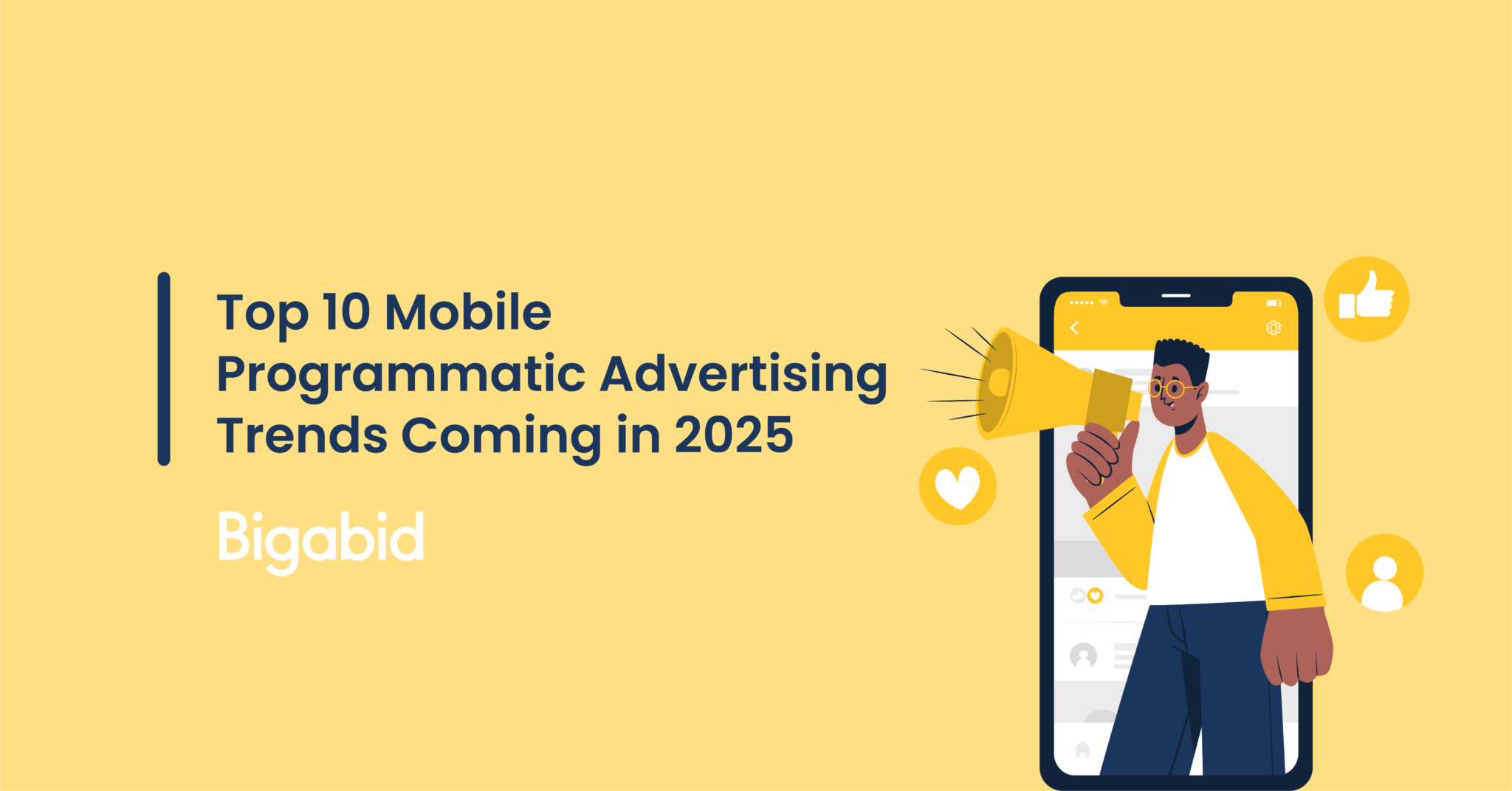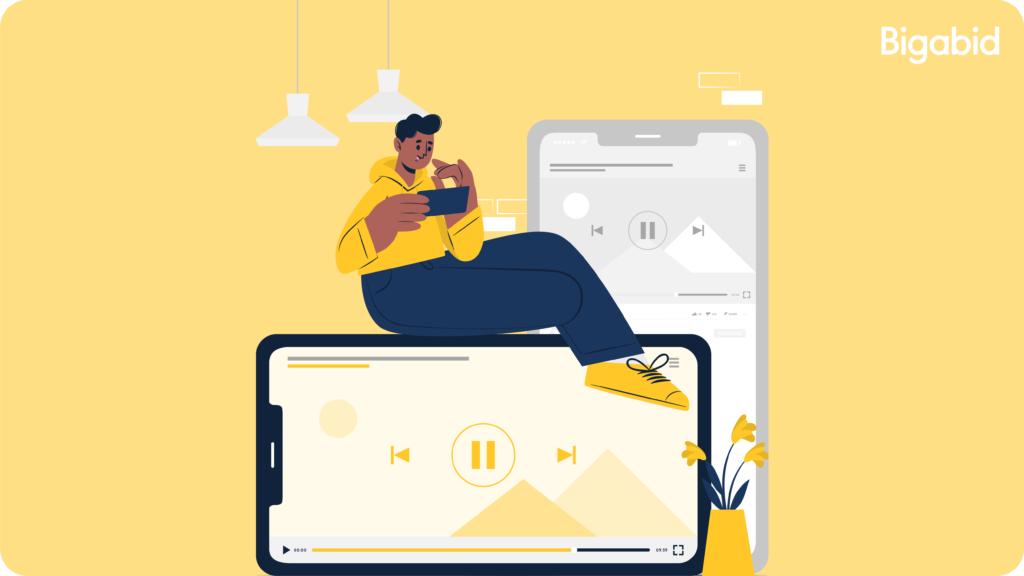
The mobile advertising landscape is evolving at breakneck speed, with no signs of slowing down. By 2025, mobile programmatic advertising is expected to dominate digital ad spend, driven by AI innovations, smarter audience targeting, and redefined strategies for app monetization. Whether you’re a mobile app marketer, developer, or advertiser, staying ahead of these trends will ensure your campaigns are not only relevant but also highly effective.
This blog will explore the top mobile programmatic advertising trends for 2025 to help you refine your app marketing strategies and maximize ROI.

–
Artificial intelligence (AI) continues to revolutionize mobile programmatic advertising. By 2025, AI will be more integral in demand-side platforms (DSPs), delivering refined user acquisition strategies, smarter retargeting, and enhanced in-app ad personalization.
AI-driven DSPs analyze enormous datasets in real-time, automatically optimizing ad placements to ensure marketers reach their target audience at the optimal time and on the best platform. This results in:
Moving forward, leveraging AI-powered DSPs will become critical for app developers looking to boost user acquisition efficiently.
Here’s a pro tip from Wu Lei (Allen), Head of APAC for Bigabid, “In today’s fast-paced digital world, marketers need to reach their target audience at the optimal time and on the best platform. This ensures better engagement and leads to a higher return on ad spend (ROAS). With advancements in machine learning (ML) tools, marketers can now leverage AI-empowered demand-side platforms (DSPs) like Bigabid to make real-time decisions that result in improved targeting and reduced wasteful spending”.

Connected TV (CTV) is rapidly becoming a sought-after channel for app advertisers. By 2025, the lines between traditional mobile programmatic advertising and CTV targeting will blur, enabling mobile platforms to create cross-device strategies for a cohesive user experience.
Why It’s a Game-Changer: The convergence of mobile and CTV will allow advertisers to amplify brand exposure while increasing app downloads and monetizing ads more effectively.

Privacy regulations like GDPR and Apple’s App Tracking Transparency (ATT) have shaken the industry, limiting the use of third-party cookies. By 2025, contextual targeting will rise as a dominant strategy for mobile app advertising.
Instead of relying on user data, contextual targeting focuses on delivering ads based on the content a user interacts with. For instance, an in-app ad for a fitness tracker might display alongside a mobile fitness app instead of being solely tied to user-specific data.
Benefits of Contextual Targeting:
Wu Lei (Allen) ’s Pro Tip – ”With the increasing concern around user privacy and data protection, contextual targeting has become a popular alternative to traditional personalized advertising. Partner with a DSP that enables advanced contextual targeting options while staying privacy-compliant.”

By 2025, mobile users are expected to spend more time-consuming audio and video content on their devices. This shift means programmatic audio and video ads will play a pivotal role in ad strategies.
What’s Trending:
If you’re not already running a mix of video and audio campaigns, 2025 will be the year to start.

Retargeting continues to boast some of the highest ROI among mobile app marketing trends. However, by 2025, retargeting will evolve beyond re-engagement ads, incorporating more sophisticated strategies with AI and predictive modeling.
The key to successful retargeting in 2025 will lie in balancing ad relevance with non-intrusive delivery.
Wu Lei (Allen) ’s Pro Tip – “Be selective when choosing a retargeting partner. Look for platforms that specialize in AI-driven predictive models to keep users engaged while respecting evolving privacy norms.”

The traditional banner ad is quickly becoming a relic of the past. App monetization strategies are shifting toward sophisticated in-app ads that maximize both revenue and user satisfaction.
Mobile app developers are placing greater focus on user-centric ad experiences:
By staying ahead of app monetization trends, developers can derive more value from in-app ads while maintaining user loyalty.
Wu Lei (Allen)’s Pro Tip – “Focus on ad placement strategies that match your app’s core experience without disrupting user flow. Also, consider offering users a way to opt out of certain types of ads to improve overall user satisfaction.”

Gone are the days of manual A/B testing. By 2025, automation will dominate campaign optimization across mobile programmatic advertising. AI and machine learning will take over ad strategy adjustments, saving time and reducing human error.
Big Wins for Automation:
For a competitive edge, adopting fully automated mobile ad platforms will be crucial.

Social commerce is set to explode, with platforms like Instagram and TikTok serving as both digital storefronts and ad hosts. By 2025, mobile programmatic advertising will see a massive influx of in-app ads tailored for social shopping.
How It’s Transforming Advertising:
Complement app ads with shoppable experiences to drive conversions and expand reach.

Widespread 5G adoption by 2025 will impact mobile programmatic advertising profoundly. Faster speeds and improved network stability will allow for richer, more immersive ad experiences.
Expect the following advancements:
Leverage these network enhancements to bring speed and interactivity into your mobile app marketing trends.

Deep neural networks are revolutionizing ad targeting and optimization within demand-side platforms (DSPs). With the help of artificial intelligence, DSPs can now analyze vast amounts of data in real-time to make informed bidding decisions.
This technology enables:
By utilizing deep neural networks in your mobile programmatic advertising strategies, you can achieve higher ROI and better engage with your target audience.
Mobile programmatic advertising is evolving rapidly, offering exciting opportunities for user acquisition, retargeting, and ad monetization. Whether you’re engaging users with rewarded ads, driving conversions via AI-powered algorithms, or adopting new app monetization trends, the key in 2025 will be staying adaptable.
Want to improve your mobile programmatic campaigns? Make sure you integrate with a cutting-edge DSP like Bigabid to maximize efficiency and ROI. Stay ahead of these industry trends to ensure your app marketing is always one step ahead.
Which of these app marketing trends are you ready to implement? Reach out to us to create the right strategy for your app!